
The Angara is a major river in Siberia, which traces a course through Russia's Irkutsk Oblast and Krasnoyarsk Krai. It drains out of Lake Baikal and is the headwater tributary of the Yenisey. It is 1,849 kilometres (1,149 mi) long, and has a drainage basin of 1,039,000 square kilometres (401,000 sq mi). It was formerly known as the Lower or Nizhnyaya Angara. Below its junction with the Ilim, it was formerly known as the Upper Tunguska and, with the names reversed, as the Lower Tunguska.

Bratsk is a city in Irkutsk Oblast, Russia, located on the Angara River near the vast Bratsk Reservoir. It had population of 224,071 (2021 Census).

The Itaipu Dam is a hydroelectric dam on the Paraná River located on the border between Brazil and Paraguay. It is the third largest hydroelectric dam in the world, and holds the 45th largest reservoir in the world.

Hydroelectricity, or hydroelectric power, is electricity generated from hydropower. Hydropower supplies 14% of the world's electricity, almost 4,210 TWh in 2023, which is more than all other renewable sources combined and also more than nuclear power. Hydropower can provide large amounts of low-carbon electricity on demand, making it a key element for creating secure and clean electricity supply systems. A hydroelectric power station that has a dam and reservoir is a flexible source, since the amount of electricity produced can be increased or decreased in seconds or minutes in response to varying electricity demand. Once a hydroelectric complex is constructed, it produces no direct waste, and almost always emits considerably less greenhouse gas than fossil fuel-powered energy plants. However, when constructed in lowland rainforest areas, where part of the forest is inundated, substantial amounts of greenhouse gases may be emitted.

Bratsk Reservoir (Russian: Братское водохранилище, romanized: Bratskoye vodokhranilishche) is a reservoir on the Angara River, located in the Lena-Angara Plateau of Irkutsk Oblast, Russia. It is named after the city of Bratsk, the largest city adjacent to the reservoir. It has a surface area of 5,470 km2 (2,110 sq mi) and a maximum volume of 169.27×1012 litres (3.723×1013 imp gal; 4.472×1013 US gal).
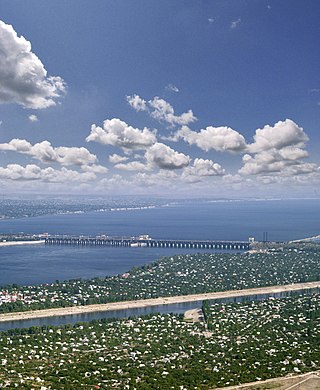
The Volga Hydroelectric Station or Volga GES also known as the 22nd Congress of the CPSU Stalingrad/Volgograd Hydroelectric Power Station, is the largest hydroelectric station in Europe, and the last of the Volga-Kama Cascade of dams, immediately before the Volga River flows into the Caspian Sea. It was the largest powerstation in the world between 1960 and 1963. Today, it is operated by the partly government-owned electricity company RusHydro.

The Sayano-Shushenskaya Dam is located on the Yenisei River, near Sayanogorsk in Khakassia, Russia. It is the largest power plant in Russia and the 12th-largest hydroelectric plant in the world, by average power generation. The full legal name of the power plant, OJSC [Open Joint-Stock Society] P. S. Neporozhny Sayano-Shushenskaya HPP [hydro power plant], refers to the Soviet-time Minister of Energy and Electrification Pyotr Neporozhny. As of 2009 the head of the power plant was Valery Kyari.
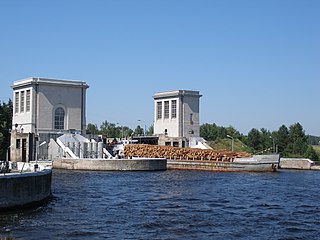
The Nizhny Novgorod Hydroelectric Station or Nizhny Novgorod GES is a hydroelectric station on the Volga river. Located near Zavolzhye, Nizhny Novgorod Oblast, it belongs to the Volga-Kama Cascade of dams.
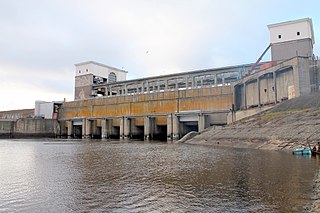
Rybinsk Hydroelectric Station or Rybinsk GES is a hydroelectric station on the Volga and the Sheksna rivers in Yaroslavl Oblast near the Rybinsk town. It is the third of the Volga-Kama Cascade of dams.
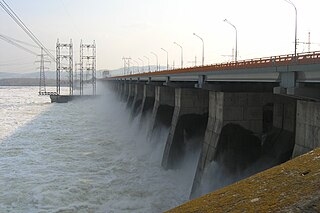
The Zhiguli Hydroelectric Station or Zhigulyovskaya Hydroelectric Station, formerly known as Kuybyshev Hydroelectric Station is a large dam and hydroelectric station on the Volga River, located near Zhigulyovsk and Tolyatti in Samara Oblast of Russia. It is the sixth stage of the Volga-Kama Cascade of dams, and the second of them by in terms of installed power quantum.

The Iron Gate I Hydroelectric Power Station is the largest dam on the Danube river and one of the largest hydro power plants in Europe. It is located on the Iron Gate gorge, between Romania and Serbia.

The Boguchany Dam is a large hydroelectric dam on the Angara River in Kodinsk, Krasnoyarsk Krai, Russia. It has an installed capacity of 2,997 MW. Construction of the power plant was completed when a ninth and final generator was brought online in January 2015.

The Ust-Ilimsk Hydroelectric Power Station is a concrete gravity dam on the Angara River and adjacent hydroelectric power station. It is located near Ust-Ilimsk, Irkutsk Oblast in Russia and is the third dam on the Angara cascades. Construction of the dam began in 1963, its reservoir began to fill in 1974, and the power plant was commissioned in 1980.
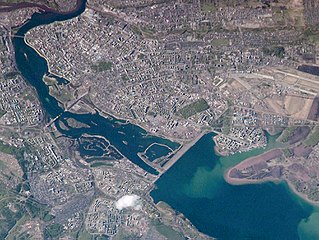
The Irkutsk Hydroelectric Power Station is a rock-fill dam on the Angara River with an adjacent hydroelectric power station. It is located adjacent to Irkutsk, Irkutsk Oblast in Russia and is the first dam on the Angara cascades. Construction on the dam began in 1950, its reservoir began filling in 1956 and its first turbines were also commissioned in 1956. It was the first large hydroelectric power station constructed in Eastern Siberia and its completion was hailed by the Soviets as an engineering success.

Hydropower is the most used form of renewable energy in Russia, and there is large potential in Russia for more use of hydropower. According to the International Hydropower Association Russia is the seventh largest producer of hydroelectricity in 2020. It is also second in the world for hydro potential, yet only 20% of this potential is developed. Russia is home to 9% of the world's hydro resources, mostly in Siberia and the country's far east. At the end of 2005, the generating capacity from hydroelectric sources in Russia was 45,700 MW, and an additional 5,648 MW was under construction. The World Energy Council believes that Russia has much potential for using its hydro resources, with a theoretical potential of about 2,295 TWh/yr, with 852 TWh being economically feasible.

Kyiv Hydroelectric Station is a run-of-river power plant on the Dnieper River in Vyshhorod, Kyiv Oblast, Ukraine. The 288 m (945 ft) long dam creates the Kyiv Reservoir with the purpose of hydroelectric power generation and navigability with the dam's associated lock. The first of 20 generators in the power station was commissioned in 1964, and the last in 1968. Together with the Kyiv Pumped Storage Power Plant, it creates a hydroelectricity generating complex. It is operated by the Ukrhydroenergo. Turbines for the plant were produced by the Kharkiv Factory Turboatom, and generators by the Kharkiv Factory "Elektrovazhmash".

Carrigadrohid hydroelectric power station is a hydroelectric plant located on the River Lee in County Cork, Ireland. It is owned and operated by the ESB Group. The dam is 130 m (427 ft) long and has a single 8 MW (11,000 hp) Kaplan turbine which produces an average of 22 GWh (79 TJ) each year. Built between 1952 and 1957. the construction of Carrigadrohid required the destruction of over half of the Gearagh, an ancient alluvial forest, and initially harmed local wildlife. However, subsequently the area has seen the growth of an ecosystem with kingfishers, otters, salmon and swans, which has been designated European Union Special Area of Conservation.

Golden Falls hydroelectric power station is a hydroelectric plant located on the River Liffey in County Kildare, Ireland. It is owned and operated by the ESB Group.
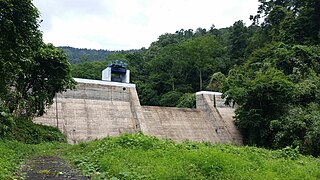
Veluthodu dam is a part of Kakkad Hydro Electric Project and is located in Seethathode panchayath of Ranni Taluk in Pathanamthitta District of Kerala, India. It's a Concrete-Gravity dam built across the Veluthodu river, a tributary of Kakkad River which is again a tributary of Pamba River. The dam is built primarily for electricity. This diversion dam diverts water to the water conductor system from Moozhiyar reservoir to Kakkad Power Station. This power station utilises the tail race water from Sabarigiri power station and flow received from moozhiyar and velluthode rivers. After power generation, water from Kakkad power station is released to the Kakkad River. Taluks through which release flow are Ranni, Konni, Kozhencherry, Thiruvalla, Chengannur, Kuttanadu, Mavelikara and Karthikappally. It is operated by Kerala State Electricity Board.



















